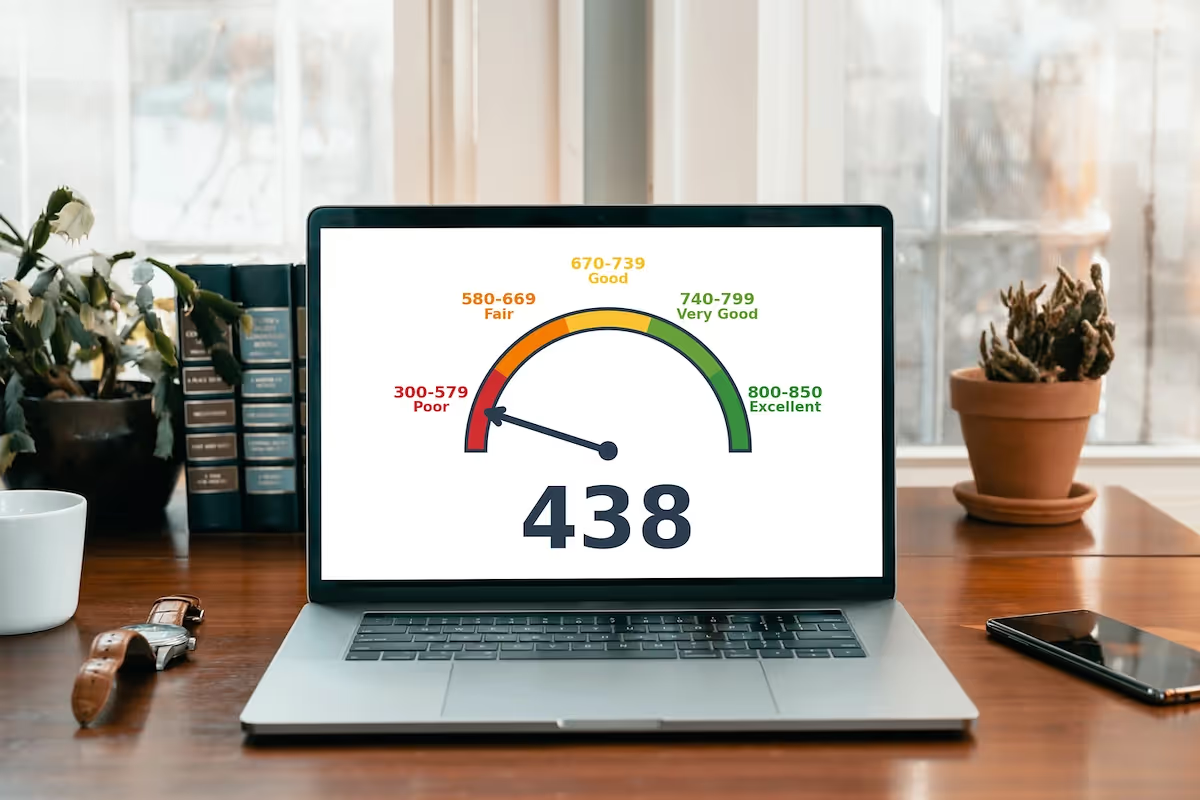
Kudos has partnered with CardRatings and Red Ventures for our coverage of credit card products. Kudos, CardRatings, and Red Ventures may receive a commission from card issuers. Kudos may receive commission from card issuers. Some of the card offers that appear on Kudos are from advertisers and may impact how and where card products appear on the site. Kudos tries to include as many card companies and offers as we are aware of, including offers from issuers that don't pay us, but we may not cover all card companies or all available card offers. You don't have to use our links, but we're grateful when you do!
438 Credit score: What You Need to Know in 2025
July 1, 2025


TL;DR
A 438 credit score offers a valuable opportunity to build a stronger financial foundation, though it may present some initial hurdles. According to the FICO model, this score falls into the "Poor" category, highlighting clear pathways for improvement.
What Does a 438 Credit Score Mean?
A 438 credit score falls squarely into the "poor" range on the FICO scale, which spans from 300 to 850. For lenders, this number indicates a high-risk borrower, which can create significant financial hurdles. You may find it difficult to get approved for new loans or credit cards. Any credit you do secure will likely come with steep interest rates and less-than-ideal terms, making borrowing a costly endeavor.
While this score presents immediate challenges, it's not a permanent state. Think of it as a baseline from which you can begin to build a stronger financial future. Understanding the factors that contributed to your score is the crucial first step on the path to improvement. Over time, it's entirely possible to rebuild your credit and gain access to more favorable financial products.
Who Has a 438 Credit Score?
While a 438 credit score is significantly below the average for any age group, it's helpful to see how scores typically break down by generation. According to 2023 Experian data, average credit scores tend to rise steadily with age:
- Generation Z (ages 18-26): 680
- Millennials (ages 27-42): 690
- Generation X (ages 43-58): 709
- Baby Boomers (ages 59-77): 745
- Silent Generation (ages 78+): 760
Credit Cards With a 438 Credit Score
A credit score of 438 falls into the 'very poor' range, which can make qualifying for a new credit card a significant challenge. Lenders generally view scores this low as a sign of high risk, meaning you're likely to face rejection for most traditional, unsecured credit cards. Your options will probably be limited to secured cards that require a cash deposit or certain unsecured cards designed for bad credit, which often come with high fees and interest rates.
Kudos offers AI-powered tools like its Explore Tool, which provides personalized credit card recommendations based on your unique financial goals and spending habits. The platform also provides credit score insights to show how applying for a new card might impact your credit, helping you make a more informed decision.
Auto Loans and a 438 Credit Score
A 438 credit score places you in the deep subprime category, which can make securing an auto loan difficult. According to 2025 auto loan data, while approval is still possible, you should expect to face some of the highest interest rates offered by lenders.
- Super-prime (781-850): 5.25% for new cars and 7.13% for used cars
- Prime (661-780): 6.87% for new cars and 9.36% for used cars
- Non-prime (601-660): 9.83% for new cars and 13.92% for used cars
- Subprime (501-600): 13.18% for new cars and 18.86% for used cars
- Deep subprime (300-500): 15.77% for new cars and 21.55% for used cars
Mortgages at a 438 Credit Score
A 438 credit score is significantly below the minimum threshold for nearly all mortgage products. Even government-backed FHA loans, which are the most lenient, typically require a score of at least 500 with a 10% down payment. While some specialty subprime lenders might consider lower scores, mainstream mortgage qualification is highly improbable.
In the rare event you find a willing lender, a low score results in less favorable terms. Expect significantly higher interest rates, which can add tens of thousands of dollars over the life of the loan. Lenders will also likely require a larger down payment and subject your finances to intense manual underwriting.
What's in a Credit Score?
Figuring out what goes into your credit score can feel like trying to solve a complex puzzle, but it generally boils down to a handful of key elements. The most common factors include:
- Your payment history, which tracks whether you pay your bills on time, is the most significant factor.
- Credit utilization, or the amount of credit you're using compared to your total available credit, also plays a major role.
- The length of your credit history demonstrates your experience with managing credit over time.
- Having a healthy mix of different types of credit, such as credit cards and installment loans, can positively impact your score.
- Finally, recent credit inquiries, which occur when you apply for new credit, are also taken into account.
How to Improve Your 438 Credit Score
While a 438 credit score presents financial challenges, it is not permanent, and taking deliberate, strategic steps can lead to significant improvement. Rebuilding your creditworthiness is a marathon, not a sprint, but consistent effort will pay off.
- Monitor your credit reports. You can obtain free reports from AnnualCreditReport.com to check for inaccuracies or fraudulent activity that could be unfairly damaging your score. Correcting errors is one of the quickest ways to see a potential score increase.
- Establish automatic bill payments. Since payment history is the most significant factor in your score, making consistent, on-time payments is non-negotiable for recovery. Automating payments ensures you build a positive track record and avoid late fees that further harm your credit.
- Apply for a secured credit card. For those with poor credit, a secured card is an accessible tool that requires a security deposit and reports your payment activity to the major bureaus. This allows you to establish a positive payment history when you might not qualify for other types of credit.
- Address collection accounts. Outstanding collections are serious derogatory marks that can weigh down your score for years. Contacting the debt collector to negotiate a settlement or payment plan is a critical step toward resolving these negative items.
An AI-powered tool like Kudos can help you manage your cards and monitor your score as you work toward your financial goals.
Unlock your extra benefits when you become a Kudos member

Turn your online shopping into even more rewards

Join over 400,000 members simplifying their finances

Editorial Disclosure: Opinions expressed here are those of Kudos alone, not those of any bank, credit card issuer, hotel, airline, or other entity. This content has not been reviewed, approved or otherwise endorsed by any of the entities included within the post.



































.webp)



.webp)

.webp)


